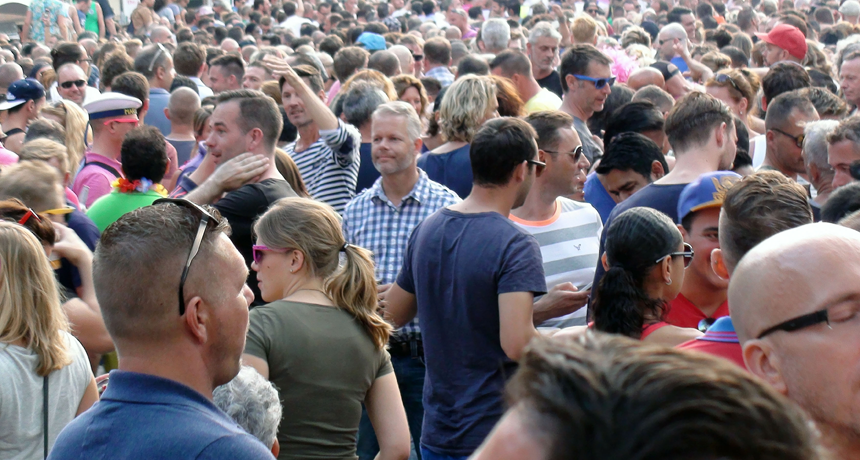Simpler way to screen for hidden hearing loss?
One test requires no high-tech tools — just a noisy room

Some people who are developing hearing loss can interpret speech fine in a quiet setting. But they can have trouble understanding speech in a crowd, as here. And that was the basis for one new hearing test.
Livinus/ iStockphoto
By Lela Nargi
A June 2016 study conducted in Brazil turned up data suggesting that as many as one quarter of teens today may have serious hearing damage — and not even know it. To uncover that hearing damage, the authors put teens in a sound-proof booth to test them for tinnitus. Most people know this condition by its more common name — a ringing in the ears. But some Boston researchers may have found an even easier way to test for this damage. Chat with the kids in a noisy room.
Stéphane Maison is a hearing specialist, or otolaryngologist (OH-toh-lair-en-GOLL-oh-gist), at Harvard Medical School. He worked with researchers there and at the Massachusetts Eye and Ear Infirmary to study a group of students. In this study, the volunteers were all college aged.
Like the Brazilian teens in the June study, some of the Boston-area students also engaged in risky listening behaviors. But unlike the Brazilian teens who tested positive for tinnitus, all Boston-area students had normal hearing sensitivity. So how did Maison’s team assess whether these kids had hidden hearing loss? They tested how well they could hear in quiet and noisy environments.
In the ear’s cochlea (KOAK-lee-ah), tiny hair cells convert vibrations in the air — what we think of as sound — into electrical signals. Nearby cochlear nerve cells pick up those electrical signals. Then the nerves relay those sound messages to the brain.
Different hair cells respond to different pitches. The brain then diagnoses what the ear hears. It does this by “listening” to the incoming mix of messages. One might think of these as an orchestra of pitches arriving in the brain from those nerve cells.
After being assaulted by loud sounds, hair cells will sometimes die off. They may even disappear. That’s bad because the body cannot grow new hair cells. (They also cannot regrow cochlear nerves, for that matter.) That loss of hair cells after even some brief exposures to loud noise led doctors to suspect that these “listening” cells were the part of our hearing system most vulnerable to noise.
In fact, this view is now a bit outdated, Maison and his team report.
The cochlear nerve cells — or neurons — in noise-exposed ears can sustain damage to their synapses (Sih-NAP-sees). Those are the nerve endings that pick up those electrical signals from hair cells. Damage to these synapses has a tongue-twisting name: cochlear synaptopathy (Syn-AP-tuh-path-ee). But don’t struggle over the name. Just focus on what it means: The “wiring” used to relay sounds to the brain has become faulty.
Even in ears with no hair-cell loss, “there can be up to a 50 percent loss of the synapses between inner hair cells and cochlear neurons,” Maison’s group reports. In most cases, this damage will remain “hidden,” they add. That’s because doctors can’t see it and few have reason to test for it. Yet if patients don’t limit their exposure to loud sounds once this occurs, permanent damage — even hearing loss — may develop.
What the new study did
The Boston researchers decided to probe for evidence of this hidden damage in the college students they studied. No student, it turned out, had trouble understanding what was said in quiet environments. But those who regularly exposed their ears to loud noise struggled to understand speech in noisy environments.
More importantly, those who reported listening to loud music or other sounds also were likely to show some loss in their sensitivity to high-pitched sounds. This is “consistent with early stages of noise damage,” the researchers report. In fact, it is evidence that the brain is becoming literally deaf to certain pitches. But further testing of the students showed that their growing insensitivity to high pitches was not behind their trouble interpreting speech in a noisy environment.
Maison’s team reported its new findings September 12 in PLOS One.
Their new data offer researchers help in better understanding, diagnosing — and hopefully eventually preventing — inner ear damage. And the last is very important, the researchers note. “Noise damage early in life,” they say, such as in adolescence, “likely accelerates the age-related further loss of hair cells and cochlear neurons.” And once this damage to hearing begins, it may worsen in time, they note — “even in the absence of further ear abuse.”







